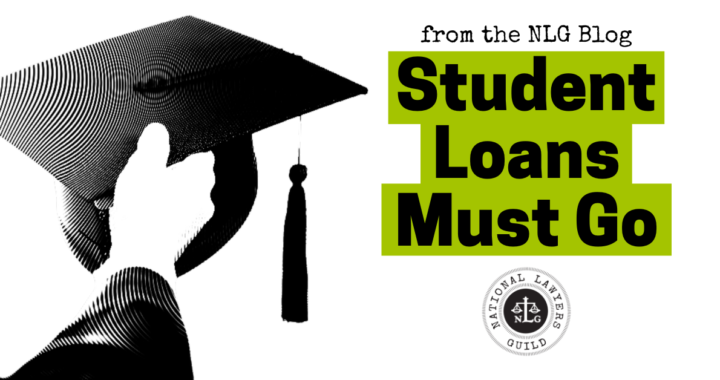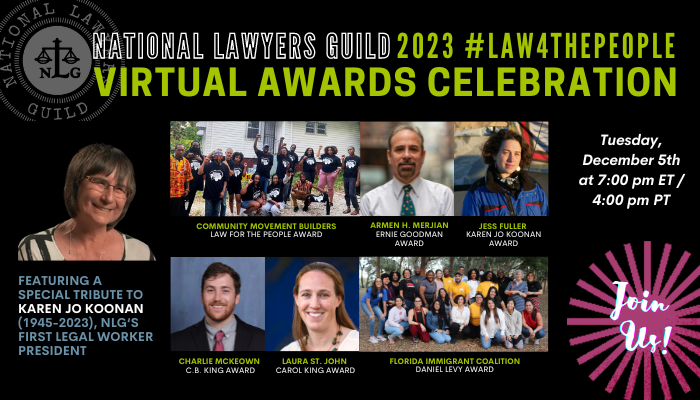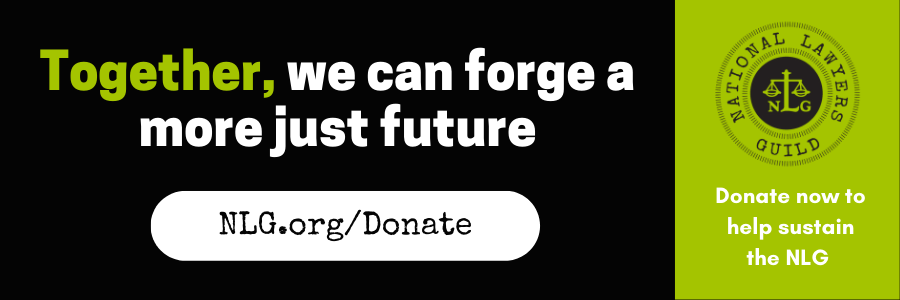By Christopher Chavis
NLG-LA Executive Director
President Joe Biden recently announced a plan to cancel a limited amount of student loans for borrowers making under $125,000 per year. The plan calls for $20,000 in cancellation for those who received Pell Grants and $10,000 for all other eligible borrowers. This plan is a critical first step in addressing the student loan crisis, but there’s still a lot to be done. This plan does not fully address the systemic inequities that fuel the student loan crisis and does not establish a plan to prevent further escalation. As students return to campuses around the country, we must ensure that this issue remains at the top of everyone’s priority list.
The existence of tuition—and by extension, student loan debt—is problematic. It commodifies knowledge and creates barriers to education, a fact that leads to the insidious idea that higher education is only a means to find employment. Students are being pushed into certain majors or fields because the status quo presents college as an investment that is meant to “pay off,” rather than a personal or intellectual experience. This is classist. A student from a lower socioeconomic background is expected to select a “lucrative” major or attend graduate programs that filter into higher-paying fields. However, a student from a wealthier socioeconomic background can “afford” to major in whatever they wish because their families can absorb the cost of their education. Their family’s financial circumstances should not dictate a student’s academic experience.
A student from a lower socioeconomic background is expected to select a “lucrative” major or attend graduate programs that filter into higher-paying fields. However, a student from a wealthier socioeconomic background can “afford” to major in whatever they wish because their families can absorb the cost of their education.
Higher education is meant to be an experience through which a student can broaden their horizons, learn new things, meet people from different backgrounds, and have experiences that contribute to personal development. The Yale Report of 1828 captured this historical mission when it plainly stated, “[t]he course of instruction which is given to the undergraduates in the college, is not designed to include professional studies. Our object is not to teach that which is peculiar to any one of the professions; but to lay the foundation which is common to them all.” At its core, higher education is meant to be a way to lay a foundation of knowledge that will be beneficial in a person’s professional and personal endeavors.
When the Yale Report was written, there were only a handful of colleges, and access to higher education was almost exclusively limited to the financially well-off. As access to higher education has grown, however, this mission has been applied inequitably. The fact that your college experience depends on parental income is an outgrowth of the classist idea that college should cost money. A student should not be sentenced to years of debt just because they dared to explore an area of personal interest. They should also not be subjected to debt for pursuing a well-rounded curriculum instead of specialization. Those who do go on to professional programs should not be saddled with debt for pursuing a less lucrative field within that profession, such as public interest law.
As the Los Angeles chapter of the National Lawyers Guild noted in our press release on this matter, student loan debt disproportionately impacts Black, Indigenous, and other people of color. Generations of intentionally racist policy decisions caused BIPOC to collectively hold less wealth than white households. “Separate but equal” was a myth propagated by white supremacists. BIPOC around the country saw their communities decimated and destroyed by white supremacist politicians who would rather sentence these communities to a lifetime of poverty than see them thrive. As opportunities to attend colleges have increased for students of color, so has tuition. As new highways to knowledge are being built, toll booths are being made right in front of them.
Tuition is also rising at a pace that far outpaces inflation. According to Law School Transparency, attending a public law school would have only cost $4,763 in 2019 dollars per year in 1985. By 2019, the average tuition was $28,186. In essence, law school is almost six times more expensive (when adjusted for inflation) than it was nearly four decades ago. The ability to attend law school with low or no debt is a privilege increasingly reserved for the wealthy or those fortunate to receive a scholarship. However, students who do receive scholarships are also often subjected to strict GPA requirements. If a student fails to meet those criteria, they either abandon law school or go into further debt to complete their studies. Neither is an optimal choice, especially considering how factors like holding a part time job, maintaining familial obligations, and facing institutional discrimination can negatively impact GPA at no fault of the student themself.
As opportunities to attend colleges have increased for students of color, so has tuition. As new highways to knowledge are being built, toll booths are being made right in front of them.
This affordability crisis results in low-income students being disadvantaged regarding career options. While programs such as Income-Based Repayment (IBR) and Pay As You Earn (PAYE) exist to lessen the burden of monthly payments, they do not erase the debt in the short term. Further, they are a band-aid that leads graduates deeper into debt. Even if students make their payments on time, negative amortization will lead them deeper into debt as interest compounds. The fact that a student can pay their loans on time and still accrue more debt represents a structural inequity designed to benefit the federal government. When interest compounds on existing debt, that is additional money that the student must pay to the federal government or private lenders, who profit from the pain inflicted upon low-income people and their families. The government should never profit from the hardships of its citizens.
This crisis has direct impacts on public interest community work. A low-income student may find it prohibitively difficult to return and serve their community and may feel pressured to take a higher-paying job, to pay down their student loan balance. While the Public Service Loan Forgiveness (PSLF) program exists to mitigate that concern, it does not fully encapsulate the myriad of ways that a person can serve their community. For example, a student who returns to serve their community by working for a small law firm would not be eligible for PSLF because they are not working for a non-profit entity. Additionally, PSLF requires ten years of qualified employment before forgiving the debt—a timeframe that may be especially daunting for students from low-income backgrounds.
It is unconscionable that higher education is hidden behind an increasingly expanding paywall. Recognition of this fact is gaining traction among lawmakers, and what was once a fringe idea is moving into the mainstream. President Biden’s limited cancellation is a step forward but more needs to be done. This issue is a matter of equity and justice. As students accumulate astronomical amounts of student loan debt, the avenues through which they can serve their communities are closing.
Americans collectively hold $1.75 trillion in student loan debt. In 2019, President Donald Trump signed a $1.9 trillion tax cut into law, which disproportionately favored corporations and high-income earners. We know that this is possible and the Biden Administration must stand on the side of equity and justice. Student loans must go.



